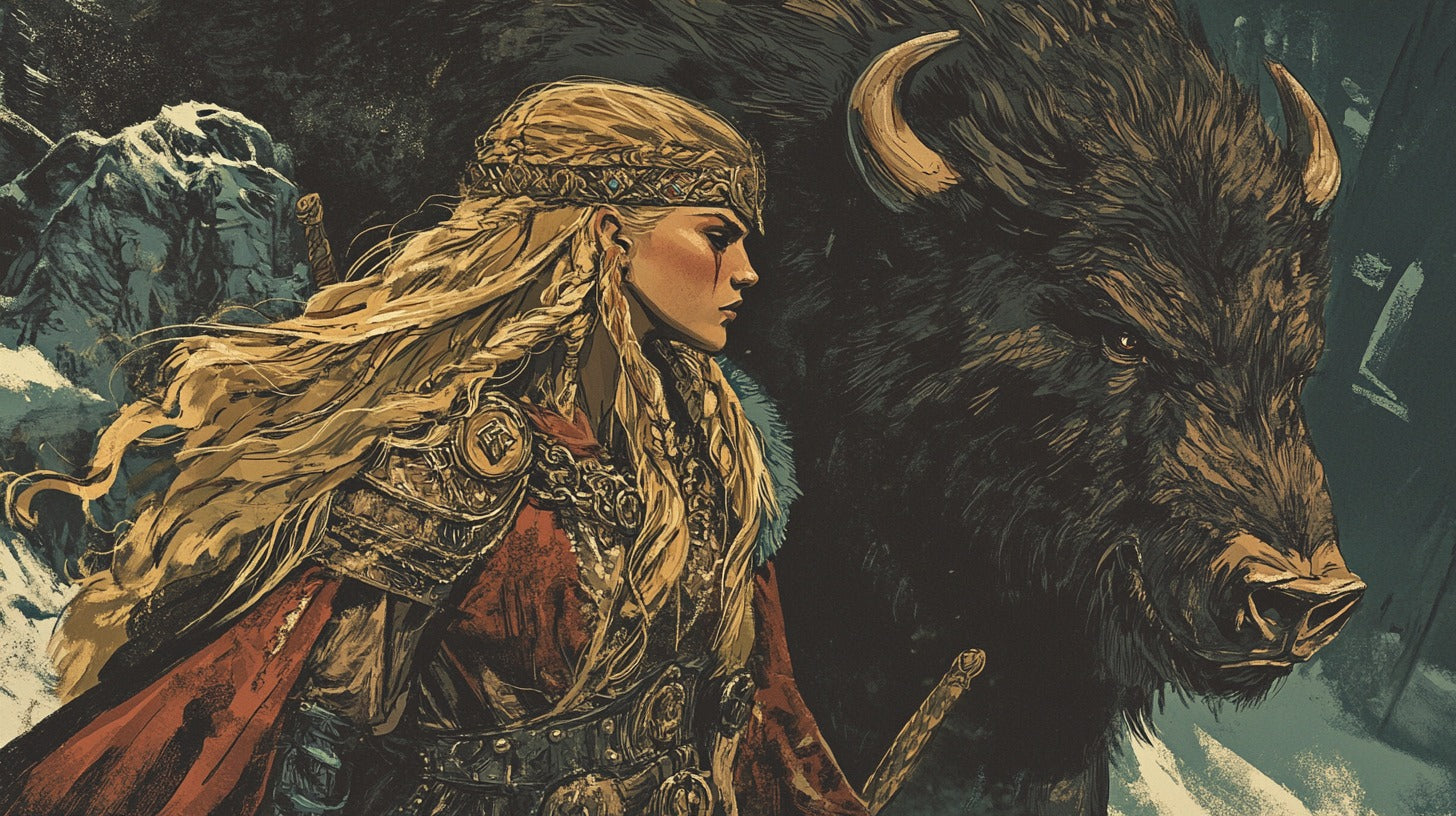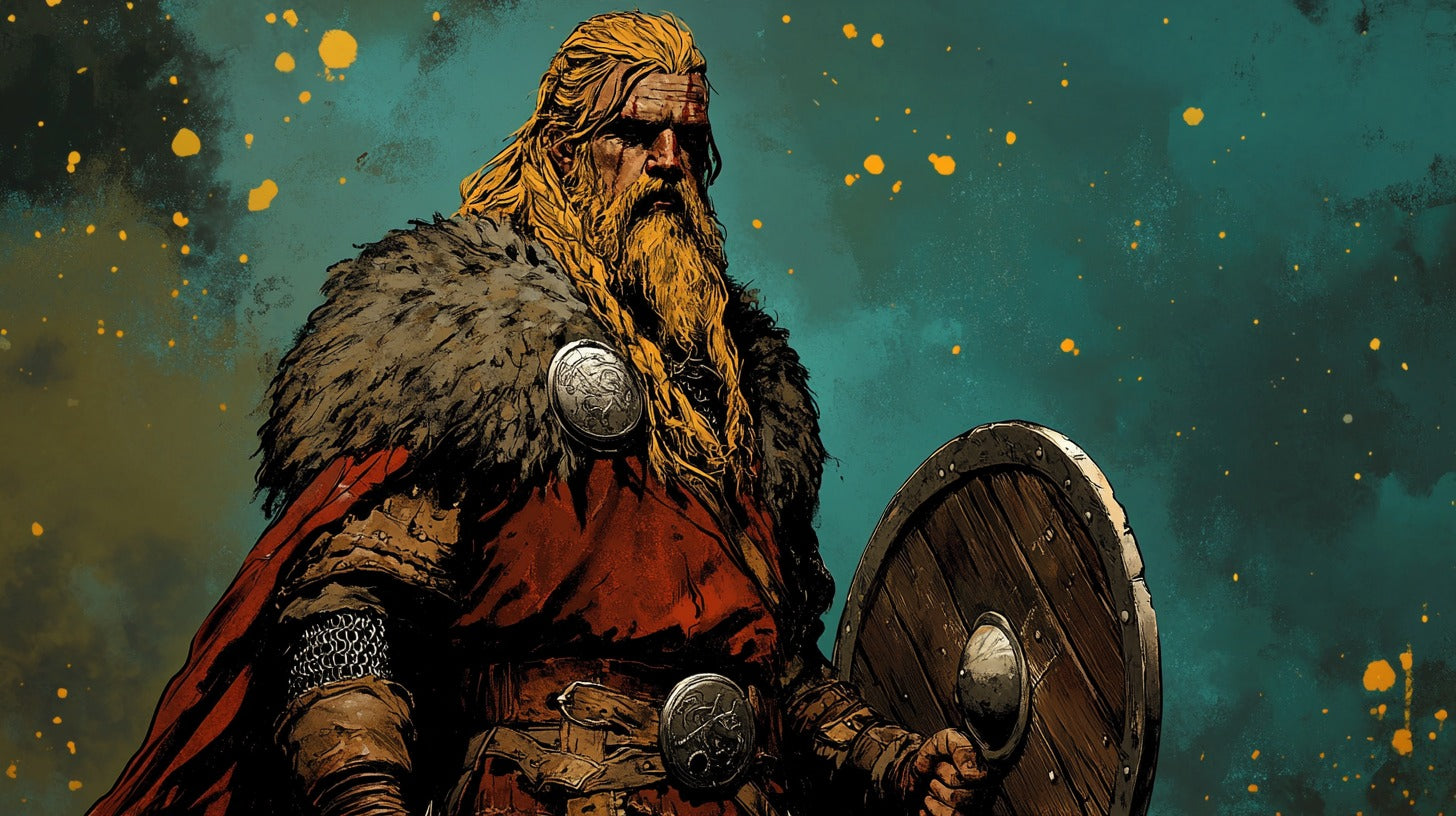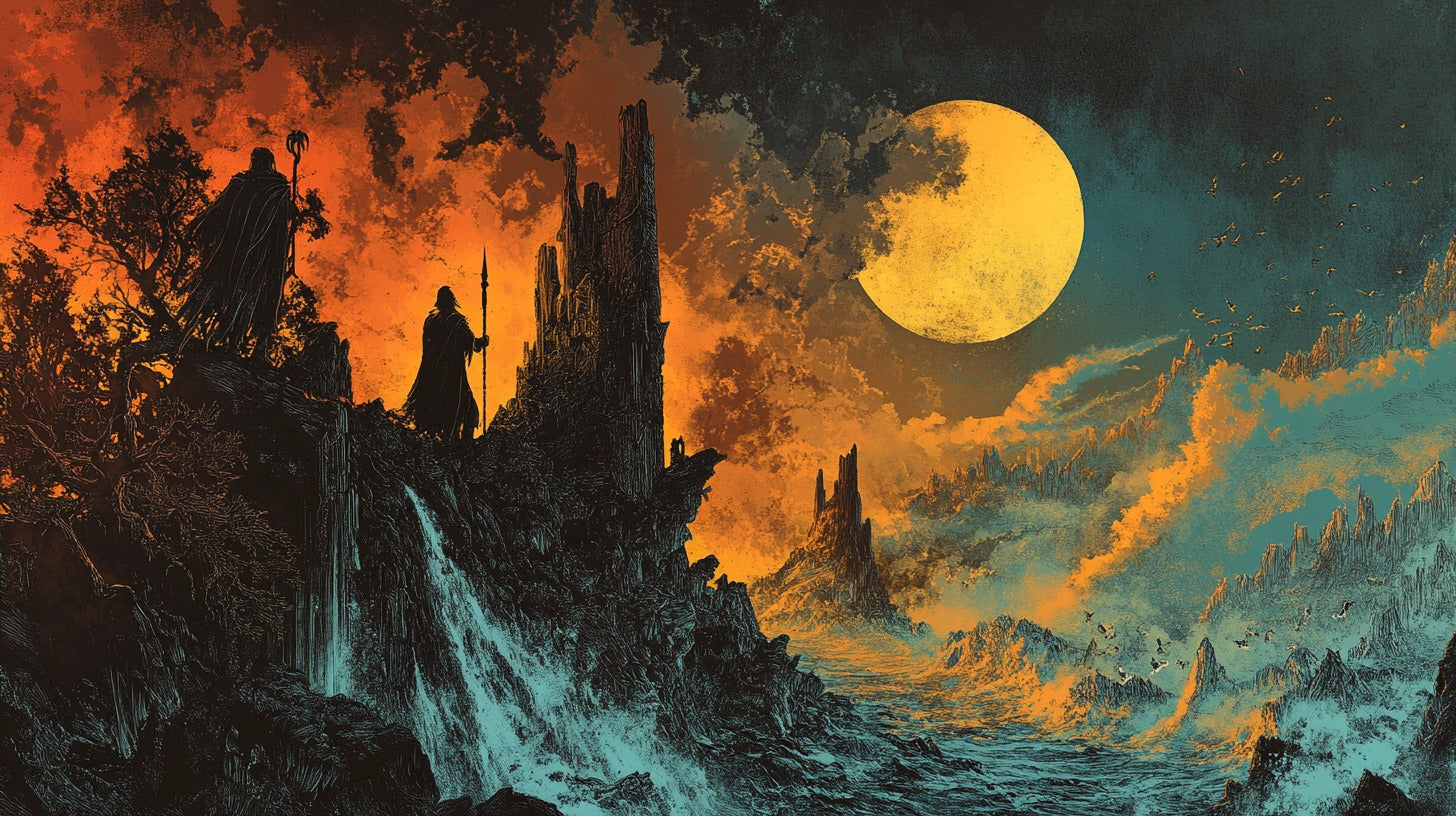
Freya: Goddess of Love, War, and Magic in Norse Mythology
In the crackling fires of Viking longhouses, where tales of gods and heroes danced on eager tongues, no name inspired more awe and wonder than that of Freya. Goddess of the Vanir, mistress of seiðr magic, and queen of her own heavenly field, Freya embodies the wild heart of Norse mythology. Her story is one of passion and power, of beauty that can reshape worlds and a warrior's spirit that can shatter them.
Origins and Family

Illustration of Freya by John Bauer (1905)
Vanir Heritage
Freya's story begins not in Asgard, the shining realm of the Aesir gods, but in Vanaheim, home of the Vanir. These nature deities, masters of sorcery and sensuality, stand apart from their more warlike Aesir counterparts. Freya, born of this mystical lineage, carries within her the primordial power of earth and sea, a magic as old as the Nine Worlds themselves.
Siblings and Relations
In the divine family tree, Freya stands tall alongside her twin brother Freyr, god of fertility and abundance. Their father, Njord, rules over the seas and winds, while their mother's identity remains shrouded in mystery, lost to the mists of time. This ambiguity only adds to Freya's allure, hinting at untold depths within her divine nature.
Freya's Domains and Powers

One of the wagons discovered in the Oseberg Viking ship burial (reconstructed) features a depiction of Freya's nine cats / Photo: Tuey, CC BY 2.0
Love and Beauty
At the heart of Freya's power lies her dominion over love and beauty. She is the epitome of desire, a force that can bring gods and mortals alike to their knees. But Freya's love is not merely the stuff of fleeting passion; it is a transformative power, capable of reshaping the very fabric of reality.
War and Death
Yet, like the land she embodies, Freya contains multitudes. Alongside her aspects of love and beauty, she stands as a formidable goddess of war and death. In her halls, she receives half of those slain in battle, claiming their souls before Odin can add them to his own ranks.
The Valkyries
As leader of the Valkyries, Freya commands these fierce warrior maidens who descend upon battlefields, choosing the worthy dead to join the ranks of the einherjar in Valhalla and Fólkvangr. This dual nature – nurturer and destroyer, lover and warrior – speaks to the complex tapestry of life and death that Freya weaves.
Freya's Magical Attributes

Hildisvíni Fehu Ring - Gold Variant
Brisingamen: The Necklace of Desire
No discussion of Freya would be complete without mention of Brisingamen, her legendary necklace. Forged by four dwarven brothers and acquired by Freya through means both cunning and controversial, this ornament is said to enhance her already formidable beauty to irresistible levels.
Falcon Cloak and Shape-shifting
Freya's mastery over seiðr, the Norse magical tradition, is exemplified by her falcon cloak. This magical garment allows her to take on the form of a falcon, soaring between worlds with the freedom of a bird. This shape-shifting ability speaks to Freya's fluid nature, ever-changing yet always true to her essence.
Hildisvíni: The Battle Boar
When not taking to the skies, Freya rides across land and sea on the back of Hildisvíni, her golden-bristled boar. This fierce creature, whose name means "battle swine," is a testament to Freya's warrior aspect, combining ferocity with the fertile symbolism of the boar.
Freya's Role in Norse Cosmology

Illustration of the flyting between Freya and Loki by Lorenz Frølich
Ruler of Fólkvangr
In the cosmic order of Norse mythology, Freya reigns over Fólkvangr, a heavenly field where half of those slain in battle reside. This realm, often overshadowed by Odin's Valhalla in popular imagination, is a place of both rest and preparation, where warriors await the final battle of Ragnarök.
Connections to Fertility and Nature
Beyond her martial aspects, Freya's connection to the natural world runs deep. As a Vanir goddess, she embodies the fertile power of the earth, the cycles of growth and decay that govern all life. Her tears, said to turn to gold upon touching the ground, speak to this transformative connection between deity and land.
Myths and Legends

A pendant found in Hagebyhöga believed to represent Freyja / Photo and Location: Swedish Museum of National Antiquities in Stockholm
The Theft of Brisingamen
One of the most famous tales involving Freya revolves around the theft of her precious necklace, Brisingamen. In this story, Loki, the trickster god, steals the necklace and Freya must enlist the help of Heimdall to recover it. The ensuing battle between Loki and Heimdall, both shape-shifted into seals, is a testament to the power and allure of Freya's most prized possession.
Freya and the Giants
Freya's beauty makes her a frequent target of the jötnar, or giants, who often seek to claim her as a bride. These tales, ranging from comical to perilous, showcase Freya's cunning and power as she outmaneuvers her would-be suitors.
The Building of Asgard's Wall
In one such tale, a giant offers to build an impenetrable wall around Asgard in exchange for Freya's hand in marriage (along with the sun and moon). The gods, thinking the task impossible, agree, only to find themselves in dire straits as the giant nears completion. It falls to Loki to sabotage the giant's efforts, saving Freya from an unwanted marriage and the cosmos from eternal darkness.
Worship and Rituals

Freya visits Hyndla while riding her boar Hildisvíni / Illustration: Lorenz Frølich
Festivals and Offerings
In the days when the Norse gods were actively worshipped, Freya held a place of high honor. Festivals dedicated to her celebrated love, fertility, and the turning of the seasons. Offerings of flowers, fruits, and honeyed mead were common, as were more personal devotions seeking her favor in matters of the heart.
Sacred Symbols and Animals
Cats, boars, and falcons were all sacred to Freya, each representing different aspects of her divine nature. The cat, in particular, became strongly associated with her, pulling her chariot across the sky in some traditions. These animals, along with symbols like the falcon feather and the golden tears, became potent focuses for those seeking to connect with Freya's power.
Freya in Modern Culture
Literature and Art
Freya's influence extends far beyond the realms of ancient myth. In literature and art, she has inspired countless works, from epic poetry to modern fantasy novels. Her complex nature – at once loving and fierce, sensual and martial – provides rich material for exploration and interpretation.
Popular Media and Neo-Paganism
In recent years, Freya has experienced a resurgence in popular culture, appearing in everything from comic books to video games. This renewed interest has coincided with a revival of Norse paganism, where Freya once again receives devotion and offerings from those who seek to connect with her ancient power.
Conclusion
As we've journeyed through the realms of Norse mythology, we've seen that Freya is far more than just a goddess of love and beauty. She is a force of nature, a being of profound complexity who embodies the very essence of life, death, and rebirth. From the mead halls of ancient Scandinavia to the digital realms of modern entertainment, Freya continues to captivate our imagination with her power, her passion, and her indomitable spirit.
In a world that often seems chaotic and unpredictable, perhaps we find comfort in the idea of a divine being who embraces both the light and the shadow, who can be both nurturing mother and fierce warrior. Or perhaps we simply enjoy the timeless tales of a goddess who moves through the cosmos with the grace of a cat and the freedom of a falcon, ever true to her own nature.
Whatever the reason, one thing is clear: as long as hearts beat with passion and souls yearn for transformation, the legend of Freya will continue to resonate in our collective consciousness, a reminder of the power of love, the allure of magic, and the enduring mystery of the divine feminine.
FAQs
- Was Freya always depicted with cats in Norse mythology?
While cats are strongly associated with Freya in modern interpretations, historical sources are less clear. Some traditions describe her chariot as being pulled by cats, while others mention different animals.
- Is Freya the same as Frigg, Odin's wife?
While some scholars have suggested they may have originally been the same goddess, in most Norse myths Freya and Frigg are distinct deities with different roles and attributes.
- Did Freya have any children?
According to some sources, Freya had a daughter named Hnoss, whose name means "treasure." Some traditions also mention a second daughter, Gersemi.
- How does Freya's role differ from that of the Valkyries?
While Freya leads the Valkyries, her role is broader. The Valkyries specifically choose slain warriors for the afterlife, while Freya's domains include love, fertility, and magic as well as war.
- Is there any connection between Freya and the day Friday?
Yes, the name Friday is derived from "Freya's Day" in Old English, though in some Germanic languages it's associated with Frigg instead.
References
Sturluson, S. (13th century). The Prose Edda. Iceland.
Ellis Davidson, H.R. (1964). Gods and Myths of Northern Europe. Penguin Books.
Lindow, J. (2001). Norse Mythology: A Guide to the Gods, Heroes, Rituals, and Beliefs. Oxford University Press.
Larrington, C. (2014). The Poetic Edda. Oxford World's Classics.
"Wagon from Oseberg collection, Vikingskipshuset (viking ship museum), Oslo" by tuey is licensed under CC BY 2.0.
"Pendant" by The Swedish History Museum, Stockholm is licensed under CC BY 2.0.








